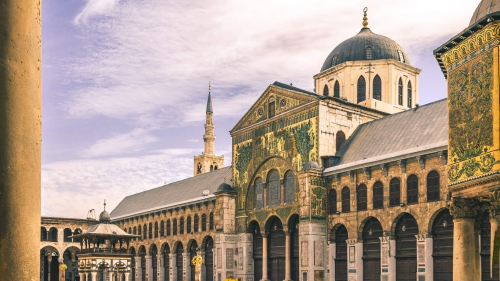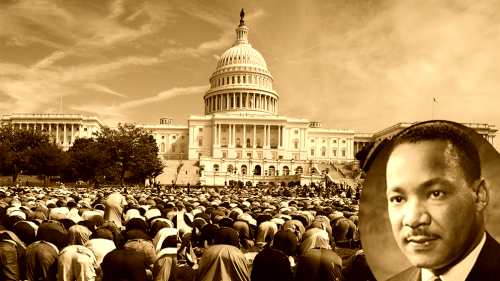Educating for Islamic Identity within American Diversity

Muslims across the United States come from a variety of ethnic, cultural, and geographic backgrounds. No other country in the world shows such diversity in the Muslim community. The number of full-time Islamic schools in the U.S. has more than quadrupled in the past 20 years. In 1987 there were only 50 Islamic schools; now there are over 300, educating 45,000 students according to the Islamic School's League of America.[1] The popularity of these schools is expected to continue rising due to growing religious awareness by the Muslim community. Despite their diversity, Muslims are united in the essentials and core values of their faith - belief in one God, Qur'an for guidance, and the Prophetic tradition serving as example. Thus the foundations of their educational system can be clearly laid down on these transcendental principles.
In addition, the American Muslim community has witnessed spectacular growth in population in the last two or three decades. Most estimates agree that it is a young community with a growth rate of 4-6 per cent per year.[2] Thus there is an urgent need for schools that are relevant to their Islamic identity so that, imbued with this spirit, they could confidently meet the requirements of their community in the American milieu - as future politicians, media consultants and executives, journalists, lawyers, teachers, engineers, and more.
The objective here is to teach our children to be both Muslim and American without compromising either of their identities. Born and raised in this country, their national identity would be American, and they should be proud of it. In the process they should not lose their religious identity but rather hold it with equal pride and affirmed conviction.
The Need for Full-time Islamic Schools
A majority of American children attend public schools. Within the realm of public schooling alternatives exist, such as charter and magnet schools, as well as opportunities for enrollment within and across districts. Private schools such as Islamic, Catholic, and non-denominational or secular schools are also available. Home schooling is also recognized and so are online and virtual schools.
For most American parents, to seek alternative forms of education requires a substantial amount of financial commitment. Therefore, their choice generally rests on three criteria; high academic standards, social climate (such as safety, a sense of community, discipline at the school, and teacher dedication) and religious or moral considerations and compatibility of values taught at home and school. However, research surprisingly shows that academics take precedence over all other considerations.
The full-time Islamic schools are relatively new, having come on the scene in the last two to three decades. However, because of the post 9/11 climate they have been subjected to close scrutiny. And because of their visibility they are subjects for studies of doctoral dissertations. Case studies carried out in selected Islamic schools over several years provide results that have local value but are nevertheless generally applicable because they agree to what is intuitively known to all concerned - i.e., parents, community members, and Muslim educators. The results are supported by a written survey, a one-on-one interview, and in small focus group discussions. We will discuss them in the following.[3]
Significant Motivators for Islamic Schools:
1. The number one concern for parents who chose an Islamic school is the Islamic environment. They expect their children to learn and internalize Islamic morals, behaviors, and practices in an environment that practically models what it means to be a Muslim - including friends that provide a sense of belonging, and a source of positive peer influence. This is apparent in such simple practices as the child's eagerness to fast, memorize Qur'an, and don hijab.
2. The most significant of all motivators for choosing Islamic schools is religious and moral education. Parents want their children to learn and live Islam in their daily lives; knowledge of Islamic teachings coupled with its practice is difficult to achieve without daylong exposure and interactions in public and weekend schools.
3. Preservation of identity instead of dissolving in the 'melting pot.' All Muslims realize this is an uphill battle but it is indispensable to bring up children with a strong sense of identity in a society where so much in vogue is diametrically opposed to Islamic teachings. Thus parents view Islamic schools as a haven to establish, nurture, and strengthen the Islamic identity of their children. At the most basic level they want their children to be Muslim and stay Muslim. But beyond this minimum they have higher aspirations: to have their children face situations in life with an Islamic mindset and make decisions based on the foundations and basic framework established in younger years.
4. Contrary to the general trend, parents who selected Islamic schools academics represented a secondary or tertiary consideration. Among additional reasons for choosing Islamic schools the most important is protection of children from the negative influences of public schools, such as drugs, violence, sexual promiscuity, and student behavior and attitudes. These considerations, coupled with their personal experiences and observations, drive many parents to the Islamic schools. Other reasons include the opportunity to learn the Arabic language, the compatibility of values taught at home with the school, strong academics, and safety.[4]
The general feeling that Islamic schools are not on a par academically with public schools is totally unwarranted. Students from Islamic schools have performed very well compared to their public school counterparts, and many of their graduates have been accepted at prestigious colleges and universities.
Benefits to Parents:
1. The most important benefit to parents is that Islamic school supports their parenting; the school reinforces what they teach at home, making their childrearing efforts easier. On the other hand, if children are enrolled in non-Islamic schools, the conflict between home and school values requires parents to work much harder to instill Islamic values in their children.
2. Parents have the peace of mind of knowing that their children are safe, knowing their schoolmates, and knowing they can practice their religion freely and comfortably without being harassed.
3. Parents can learn with and from their children. Some feel that their children know more than they and this helps them to practice their religion better.
4. The satisfaction parents get observing their children learning and practicing Islam is immeasurable.
Advantages over Public Schools: [5]
1. The most significant advantage lies in morals and behavior. Public schools expose children to non-Islamic behaviors and practices, from bad language to worse behavior, including the use of drugs motivated by peer pressure, and sexual attitudes that are harmful.
2. Positive impact on children. Children become proud and confident Muslims, acquire knowledge and practice religion with praiseworthy behavior, to the satisfaction of parents.
3. Children have a sense of belonging with people who understand and share their beliefs and practices as well as the comfort of freely practicing them. They are not challenged to fit in where people don't understand them.
However, public schools have a competitive advantage over Islamic schools in facilities and resources, programs, and services due to financial constraints faced by most parents.
Current Situation in the Muslim World [6]
Unfortunately, the state of Muslim education has deteriorated over centuries of neglect. The blame could be attributed to past Muslim rulers for not paying due attention to education. The status of education deteriorated further with colonization of Muslim lands. The only concern of today's despotic rulers is to ensure that their position is maintained at all costs. They allocate meager funds for education, keeping the masses illiterate and uneducated so that the ruling elite's status is not challenged.
Therefore, there is a great disconnect with the Islamic heritage and Muslim masses who do not live in consonance with the teachings of Islam. Creeping modernity has further eroded transcendental values and caused rampant corruption. The lack of freedom has gravely affected the Muslim people and this, in turn, has undermined the strong character development in their children. Morality cannot flourish in a climate of social, intellectual, or spiritual repression, so the masses are spiritually disoriented, socially marginalized and, in general, find themselves in a quandary about their place and role in the modern world.
For centuries, Islamic education has been imparted primarily as information to be memorized rather than to stimulate the thought processes. Thus stuck in an outmoded methodology, lacking scientific know-how and modern improvements, it has been of limited scope and utility. This approach has resulted in the adoption of Islam for personal salvation rather than putting it into practice in the everyday life of Muslim people - making it irrelevant for their future generations.
Many schools established in the U.S. follow the same practice by importing textbooks that are either given free or sold cheaply; the counter productivity of this practice is obvious.
What is needed is to create an Islamic educational system that uses modern advancements in science and technology and focuses on all areas of concern - in pedagogy (art and/or method of teaching), content (what is taught), and paradigm (pattern of education).
Islamic Schooling in the United States [7]
Possibly the first Islamic school in the United States was started by Shiekh Daud Faisal in 1928 in Brooklyn, N.Y. He was endorsed by Muslim scholars in Jordan and Saudi Arabia, worked mostly with African American converts, and was quite successful for sometime. But no trace of that school can be found today; it probably closed due to financial difficulties. Sister Clara Muhammad started the schools that are still quite active. They were initiated by the Nation of Islam and converted to Sunni orthodoxy when the leadership came under Warith Deen Muhammed.
The motives for establishing these schools were the same that we are familiar with, such as problems with sex and violence in impoverished neighborhoods as well as curricular concerns. These motives correspond with the status of current Islamic schools, which promulgate the religion and safeguard students from societal evils of drugs, racism, and pre-marital sex.
People are drawn to Islam by its idealism and this must be imparted to young Muslims. Such an orientation is the job of educators who operate Islamic schools. It should be clearly promulgated in their goals and mission statements. Systematic methodology must be put in place for achieving the stated goals and directed by the entire school culture, from the hiring and training of staff to its academics and discipline standards, using periodic public assessments of progress to ensure that programs are concordant with goals.
Most existing curricula are modifications of the secular system, because the latter are professionally developed and familiar to the majority of American-trained Muslim educators. With so much effort required in establishing a separate Islamic school it would seem that religious education is given top priority. In practice, however, educators are more concerned with meeting the academic requirements, while Arabic, Qur'an memorization, and Islamic studies take second place. Furthermore, an emphasis on rituals in Islamic studies and memorization of Qur'an are the least developed. It seems odd that the very purpose for which Islamic schools are established has remained the least developed.
Islamic schools must be clear about their agendas and the methodologies used for actualizing these agendas. Islamic concepts should constitute the starting point in every subject, and the subject should be balanced and integrated to suit a Muslim child in the American context. This requires effective, professional teachers who exemplify Islamic character and texts that incorporate the Islamic model in all subject areas.
There is great potential for Islamic educators to have a powerful impact on the American education system, if Islamic educational philosophy is properly learned and harnessed. They must make a deliberate decision to shift the emphasis and priorities towards ideals and goals with a lasting effect. This requires a renewed commitment to engendering an Islamic approach to educational philosophy with clear goals for its transmission to the youth in the American context.
Areas to Focus and Develop
The purpose of Islamic education for children is often described by the term tarbiya. Tarbiya could be defined as nurturing of the potential of a child from one stage to its next stage until learning is fully imparted. That is how we will look at the three areas of pedagogy, content, and paradigm.[8]
Pedagogy
Thanks to research on the brain and learning, we now know how children learn. If we paid any attention, we would see the research confirms what is provided for us in the Sunnah of Prophet (peace and blessings of God on him) - that a child need a safe and loving environment in which to learn. Muhammad (peace and blessings of God on him) was known by all to be a loving father, grandfather, and teacher. He spoke kindly to children, treated them according to their age, adjusting expectations as they grew and matured. And he never used intimidation as a tool in teaching.
This research has also confirmed what we can infer from the Sunnah, that when children are afraid they cannot learn because they cannot attend to both learning and threats simultaneously: The brain makes it difficult for them to learn when they are afraid since it diverts all its energy towards "flight or fight" defense strategy. A simple lesson is that when teachers provide a safe and happy environment, children's brainpower is freed to focus on learning.
The focus of religious education should be to awaken the spirituality of a person towards transcendence - to rise above the natural and mundane world, relate to a Divine Being, and commit to values beyond the secular material world, leading to a profound and heightened state of consciousness. Such education necessarily requires practicing Islamic educators to impart it to their students. Islamic educators can facilitate this awakening of spirituality and search for truth in their students and follow its demands.
Content
The content of educational curricula must focus on the personality of children and their character development. It should also provide them with real-life skills to function effectively in today's society.
It is our collective responsibility to devise an educational system that imparts to our children the tools to identify, understand, and work cooperatively, so that in time they can come up with solutions to the problems facing their community and humankind at large.
The tarbiyah (Islamic upbringing) or Islamic approach to education is framed on the principle of Tawheed. Tawheed, a cornerstone of Islamic worldview is the unity principle of our Creator and Lord of universe and demands that our thought, methodology, and practice must be brought in line with it. As a methodological construct, it gives structure and coherence to our understanding of the world and different aspects of our society. It requires adoption of a holistic, thoroughly integrated, and comprehensive view of education. This overall understanding must always be kept in mind while relating education to its goal - in educating our children, in how and what we teach them, and in organizing the teaching material around it.
The goal of Islamic education curricula beyond education should be to engender a true religious and spiritual awakening by not only familiarizing the students with Islamic beliefs and practice but also by instilling a desire to adopt and importantly build character and an Islamic personality so as to establish an Islamic identity. Therefore, Islamic attitudes and beliefs have to be infused into every activity of the school, ensuring emotional attachment and full understanding of its core beliefs, values, and practices, and a sincere desire to follow the Qur'an and Sunnah.
Paradigm
A critical component for Islamic schools is creation of a new paradigm or pattern of education that fully integrates Islamic teachings and values into the entire curriculum.
Unfortunately, the current Islamic education imitates prevalent secular systems, thereby fragmenting knowledge and reducing it into segments. Thus, as an example, mathematics does not concern itself with Islamic values or practice. In the new paradigm it must become more than mere numbers as students learn to explore and get exposed to Islamic values. For example, the teaching of statistics and probabilities may involve discussions of gambling and show actual cases of the potential loss of homes and even families. This would become a powerful integrated math and Islamic studies lesson.
Such a paradigm of integrating Islamic values and its perspective throughout the course would provide the children with an understanding that Islam is part of every aspect of our lives.
Designing such a dynamic and progressive paradigm based on the Qur'an and other authentic sources and incorporating the framework of current knowledge requires an interdisciplinary approach and the collaboration of many scholars and dedicated individuals.
Given all of the above, therefore, formulating an Islamic curriculum requires the following:
1. Faith in and knowledge about Islam. Those involved in developing an Islamic curriculum should have a comprehensive knowledge of Islam, the Qur'an and its various interpretations, and the Sunnah, based on a broad range of original authentic sources.
2. Knowledge of the learner. Since the curriculum is designed for students, the designer must take their intellectual and emotional characteristics into account. That is, its concepts, language, and design should be age appropriate.
3. Knowledge about learning and development. Children pass through several cognitive, personality, and moral development stages, and each stage demands appropriate tools and materials for learning. The learning process in curriculum development should be appropriate to these stages. Therefore, educators involved in curriculum design must familiarize themselves with the current state of knowledge about these stages.
With the availability of such persons gathering in strength, this will come about, insha Allah, with trust in God and help of the community.
Textbooks Based on the Above Criteria
A curriculum based on the above criteria will affect all aspects of imparting education. However, most affected will be the textbooks to meet our Islamic needs and its integration into academics. The secular textbooks used at public schools - despite their rich content, beautiful illustrations, and modern teaching approaches, are not useful because of the unnatural fragmentation of knowledge. Nor are the currently available Islamic books, because just as in the public schools they also fragment traditional knowledge and in addition fail to utilize modern educational pedagogy.
While some of the old "skill and drill" rote learning may be necessary and in some cases desirable, in order to produce future leaders the students must be challenged to develop critical thinking and analytical skills to strengthen and further their Islamic identity. This should be the case with regard to all subjects, secular as well as Islamic.
Also the textbooks must make children aware of the real issues of today, such as capital punishment, AIDS, drug use, premarital sex, euthanasia, business ethics, and ethics in bio-medicine, finances, and so on and so forth. And the textbooks have to teach how to deal with these issues Islamically to have relevance in their lives.
When all of the above considerations are taken into account, there is no escaping the fact that the time spent in schools needs to be appreciably longer the time students spend in public schools.
Until the entire system is overhauled, requiring committed Islamic educators, time, and money, help in addressing this textbook issue fortunately is on the horizon. Karen Keyworth, co-founder of the Islamic Schools' League of America (4islamicschools.org) suggests in her articles how recent developments available through the Internet might help solve our textbook problems. Quite a few publishing companies (for example, pearsoncustom.com) have developed techniques to create textbooks by picking and choosing aspects of the text wanted along with providing schools and/or teachers to chance to insert their own relevant material into them. Once the selections and insertions are completed, the textbook is bound and shipped within as short a period as 3-4 weeks.[9]
At present, colleges and universities are making use of this potential to tailor text to the exact specifications of a course where rapid modification has a tremendous benefit to improving quality; and students are eager to pay for it. The Islamic Schools League of America would facilitate such work provided the responsible schools respond to work closely with it.
Concluding Remarks
Despite the enormity and daunting nature of work the good news is that a number of Islamic organizations are engaged the development of curriculum criteria and the related textbooks. Thus, dynamic and progressive changes are taking place that are both exciting and positive, enabling the use of vibrant, modern pedagogy to do the crucial work of connecting Islam to our current needs. Hopefully it will be utilized eventually in all aspects of Islamic education, even in the weekend schools. This project holds tremendous promise for the future of Islamic Ummah.
Involved organizations include the following: The Islamic Schools' League of America, the Council of Islamic Schools in North America, the Tarbiyah Project, International Board of Educational Research and Resources (IBERR)[10] , and a few others. It is good to know that these organizations are working in collaboration and sharing their resources to prevent costly and wasteful duplication.
It is essential to hire well-qualified Muslim teachers to teach the integrated curricula. Therefore, the current stop-gap arrangement will have to be replaced with the hiring of qualified teachers graduating from universities across America, teachers who are born and raised here and possess excellent education skills. Such teachers will have to be paid a genuine living wage in order to motivate them.[11]
Hopefully, dedicated teachers, through their pious and careful insight, will help develop students who, with their advanced scholarship, intellectual prowess, and refined intellection into sacred knowledge, will meet in due course the challenges of the times and find solutions to the problems of Islamic community in America as well as the larger Ummah - and in the process, this will bring transcendental values to benefit the entire America.
(This article is taken from the author's 2012 book entitled Muslims At The Crossroads
Notes:
1. Susan Sachs, "Muslim Schools in the U.S. a Voice for Identity," New York Times, November 10,1998; Lauren Price, "Muslim schools gain popularity," Medill News Service, CAIR-Chicago in the News, September 11, 2006; Katie Masters, "Islamic schools rise above the rest," UPI, October 20, 2009.
2. According to an estimate of Dr. Ilyas Ba-Yunus, Professor of Sociology at State University of New York (SUNY), Cortland, approximately 50 percent of American Muslims are under the age of 20. Other estimates by Cornell University, and CAIR support the general view that American Muslims are relatively young, mostly married, and with a family size of about six.
3. Hoda Badawi, "Parental Reasons for School Choice: A Case Study of an Islamic School in the United States of America (Minnesota)," University of Minnesota, Minneapolis, Minnesota, Doctoral Dissertation, 2005; Ibid, "Why Islamic Schools?" Islamic Horizons 35(2):18-30, March/April 2006.
4.Yahya Emerick, "Working in Muslim Schools- Islamic Foundation of North America,"ifna.net. The article first appeared in "Religion and Education, Winter 1998.
Highly recommended is this article by Emerick, an American convert, writer and teacher in Muslim schools. He traces the schools from their origins to their current development. That despite their current staffing and financial problems they provide discipline, a spiritual orientation, and an environment conducive to learning. And Muslims who wish Islam to become part of the permanent religious mosaic of North America very much need such schools working towards this endeavor. This is especially important given that anti-Islamic messages that are bombarded every moment of a child's interaction with the wider society.
5. Samana Siddiqui, "Muslim Schools Versus Public Schools," Soundvision/icna.org.
6. Moiz Amjad, "The Existing Education System: A Critique". Although this article relates to the specific case of Pakistan, its conclusions apply equally to other Muslim countries.
7. Mathew Moes, "Schooling in America," Islamic Horizons 35(2):22-23, March/April 2006.
8. See note 7 above; Daud Tauhidi, "The Tarbiyah Project: An Overview," Islamic Society of North America; Mahboobeh Ayatollahzaheh, "Effective Curricula," Islamic Horizons 37(2):18-28, March/April 2008.
9. Karen Keyworth, "Trial by Fire: Islamic Schools after 9-11," Islamic Schools of America.
10. International Board of Educational Research and Resources, Cape Town, South Africa.
11. See note 4 above. Emerick laments the poor wages paid in Muslim schools, resulting in high turnover: "Thus only those who can't find a job somewhere else are likely to apply, save few stalwart activists (like myself) who dream of sacrificing in the cause of God and saving the next generation."
*****
Dr. Siraj Islam Mufti is active in interfaith and community affairs. He recently published book titled "Muslims At The Crossroads" It is about how the 9/11 tragedy adversely affected the Muslim communities in America and elsewhere - a subject rarely broached in mainstream media.
Topics: Children, Diversity Values: Education
Views: 7683
Related Suggestions
1) Actually, these institutions have Moral, Ethical, good values and not corrupted by Paganic and incorporated cultures/occassions Dating/Valentines day, Halloween, Christmas, Easter etc.).
2)The resources are not wasted on Music, Painting/Arts, Pottery and other areas. They can be used for good purposes and in good areas that will benefit to become good in Science and Math etc..

















